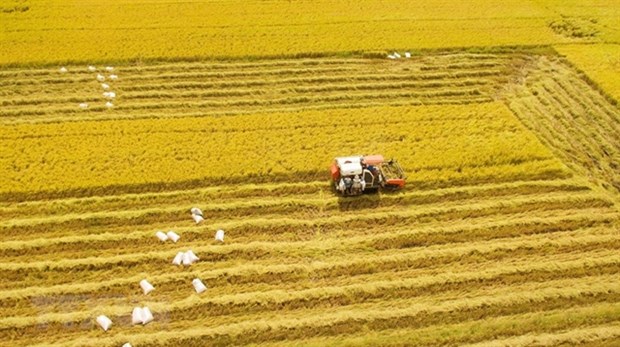2023 set to be favourable for Vietnamese rice enterprises
The Vietnamese rice industry is set to benefit from the high demand and prices this year, with lower input costs leading to expanded profit margins for rice businesses.

A rice field in Vi Thuy district in the Mekong Delta province of Hau Giang. Vietnam will benefit from the upward trend in rice prices due to limited supply. (Photo: VNA)
According to an expert from Vietnam Securities Company Limited Bank for Foreign Trade (VCBS), the country's rice industry enjoys favourable factors, such as weather and geographical advantage.
The prolonged drought in China has caused a decrease in the country's output for the 2021-2022 crop, leading to an anticipated six million tonne increase in rice imports for the 2022-23 crop.
Meanwhile, inventories in the Philippines have declined due to typhoons and high fertiliser costs, leading to increased rice imports.
The cultivated area in India has also dropped due to drought, making the decrease in supply - the main factor for the forecast of the global rice deficit.
Despite these challenges, the hydrological situation in Vietnam has been stable, with heavy rain in the past year and a neutral outlook in the first half of this year, leading to sound output.
VCBS appreciates the possibility that Vietnam will benefit from the upward trend in rice prices due to limited supply and the shift in demand from India this year.
The rising food demand has pushed the price of Indian rice exports to the highest level in nearly two years.
A Vietnamese trader also noted that global demand for rice has been increasing due to concerns about global instability.
The total commodity of rice is expected to reach 4.1 billion tonnes in the first six months of this year, with rice exports reaching 390,000 tonnes in January.
The consumption of commodity rice in the remaining five months is expected to reach 3.73 million tonnes, not including the amount of rice imported from India and the amount of rice flowing from Cambodia to Vietnam.
VCBS also reported that European countries had eased sanctions and opened their doors to Russian fertiliser exporters, while China has loosened its fertiliser export quota from June last year.
This development is forecasted to decrease input costs for rice production, contributing to an improvement in the profit margin of enterprises.
Although exports grew last year, the cost of rice production also increased sharply, "eroding" the profits of many businesses.
The Vietnamese Food Association (VFA) reported that the cost of rice production rose sharply last year, pushing up the purchase price of rice and commodity rice and putting pressure on rice exporters.
Despite the challenges faced last year, analysts expect Vietnamese rice exporters to be more favourable this year as rice prices remain high and many production costs and rice exports gradually decrease, increasing the profit margin of enterprises in the rice industry./.
VNA

